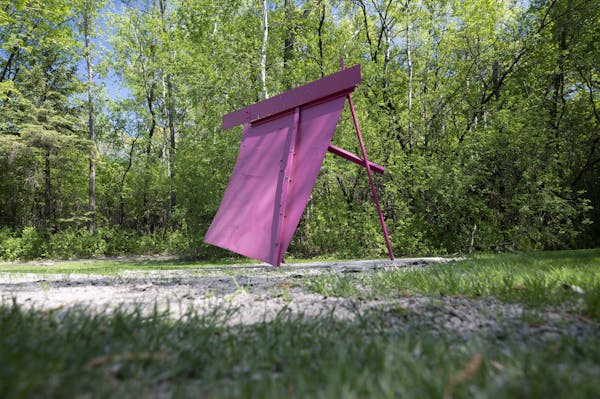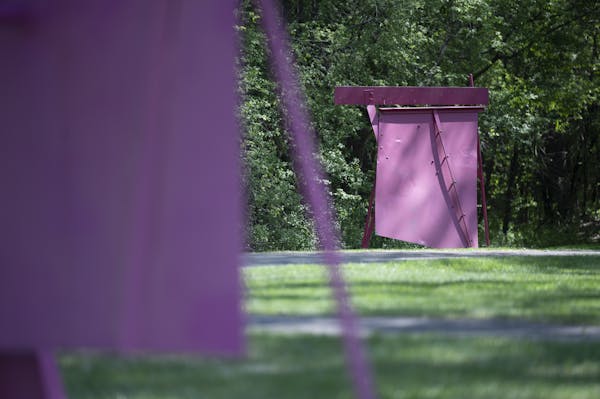Portrait of the Artist as a Generous Man
By Katie Johnson ’19, content specialist
July 30, 2021 | 8 a.m.

Professor of Art Emeritus Stewart Luckman's influence on Bethel's Department of Art and Design can't be measured.
If you were to walk along the paths behind Bethel’s Anderson Center, you’d come across vibrant sculptures tucked between foliage, close to a little pond home to ducks, algae, and dragonflies. These eye-catching works of art were donated by Professor of Art Emeritus Stewart Luckman and his family in honor of President Emeritus Jay and Barb Barnes. They’re part of a series called “Highways and Byways” in reference to the compelling images and shapes seen in construction sites along the side of the road. University Professor of Art Kenneth Steinbach, who was one of Stu’s students 30 years ago, remembers Stu sharing his process as he created the very sculptures he would one day donate to Bethel.
Today, Steinbach works in Stu’s former office in the Department of Art and Design, and he had the privilege of collaborating with the Luckmans to transport these large pieces from their Seattle home to Bethel’s St. Paul campus in March 2020. A year later, working with Bethel Facilities Management, Steinbach successfully installed the sculptures with Stu’s original ideas in mind. “I tried to position them in such a way that some of that beauty comes out,” Steinbach explains in describing how the installation emphasizes the dynamic between the materials. “The niches that are set into the surrounding foliage is a great counterpoint to his work. The tension between the natural setting and the vibrant painted steel is very powerful and very charged.”
These sculptures honor the rich history of art and design at Bethel, the gracious influence the Barnes family has had on the university, and now Stu Luckman’s legacy as an artist and teacher. Stu passed away in November 2020, deeply loved by his wife Marilyn ’58; son Sean ’92 and his wife Candace; son Nils ’93 and his wife Julie ’92; sister Evangeline and her husband Harold Alexander; brother David and his wife Susan; six nieces and nephews; and grandchildren Shannon, Ivan, Declan, and Seamus Luckman. Stu’s life was full of travel, creativity, and deep connections between family, friends, students, and fellow artists—ultimately, the impact he had on others was immeasurable.
According to Marilyn, Stu was a renaissance person who loved integrating different areas of interest whenever he could. He was born in Fitchburg, Massachusetts, and spent years of his childhood as a missionary kid in Ethiopia. His secondary education occurred across Kenya, England, France, and Italy before he returned to the United States, eventually attending Stony Brook Prep School in New York. He earned a B.A. in Political Science at Bethel in 1959, where he met Marilyn as she pursued her degree in English. “I can honestly tell you,” Marilyn says. “We have a cadre of friends that we went to Bethel with, and are still friends with them to this day.” They were in each other’s weddings and have remained part of one another’s lives, 60 years after graduation.
At the beginning of their careers, Marilyn and Stu moved to Washington state to be near Stu’s family who had returned from their overseas missions work. They both used their liberal arts education to teach high school subjects, which caught the attention of their colleagues, who often asked Marilyn and Stu for teaching support or advice. Since Stu happened to be learning woodcarving from a Native American community, the high school administration had him teach an art class as well. When he realized his high school students had artistic talents beyond his own mentorship capabilities, he knew he needed to expand his expertise. The Luckmans moved back to Minnesota for Stu to earn his Bachelor of Fine Arts and Master of Fine Art at Macalaster College and the University of Minnesota before returning to Bethel to develop a sculpture program in the Bethel Art Department.
Loading Gallery...
These sculptures are part of a series called “Highways and Byways” in reference to the compelling images and shapes seen in construction sites along the side of the road.
Throughout his time at Bethel, Stu connected with his students as he helped support their creative practices, spiritual disciplines, and career trajectories. To this day, art alumni will knock on Steinbach’s door to see the office and share their memories of Stu. “They tell me these stories about what a huge impact Stu had on their lives or how he had changed the course of their careers. For some it was a move into an artistic or sculptural career, for others it was changing the trajectory in another way, where they realized things about their lives or faith that was very pivotal,” Steinbach says “His interaction with them was often so meaningful they want to share it with somebody.”
Marilyn and Steinbach both relay that many of Stu’s students are currently world-renowned artists, professors, and art department chairs. One was a 2018 Guggenheim Fellow, and another is a medical doctor and artist in Des Moines, Iowa. “As a teacher, he mentored an amazing number of really terrific sculptors and artists in other media who are having terrific careers in many areas of the art world,” Steinbach says. Some of these alumni will be attending Stu’s memorial service at the beginning of October in Seattle.
Several current art and design faculty were shaped by Stu in some way, either directly through their Bethel art classes or indirectly as they now step into a department he helped create, including Steinbach, who remembers his time as a 19-year-old exploring an unexpected interest in ceramics. Ready with a collection of clay pots, Steinbach knocked on Stu’s door and asked him to offer feedback on his work. Stu not only offered feedback, but talked with Steinbach about why this work mattered and gave personal lectures that sometimes lasted an hour long, filled with stories, histories, and meaningful questions. Steinbach continued making art for the chance to talk with Stu and soak up his enthusiasm for the creative process and practice.
— Kenneth Steinbach, university professor of art
Stu’s most productive time as an artist was during the decade he commuted between St. Paul and Seattle, after Marilyn moved back to Washington during her 40 years as an administrator. Stu had connected with a flight attendant, who offered him her discount so he could return home every other weekend for a round trip of only $94. This way, Stu could continue to invest in both his students and his family, overlapping when his sons Sean and Nils and daughter-in-law Julie (Cook), attended Bethel. Stu’s artwork during that time and after has been featured all over the world—including New York, Washington, California, Michigan, Florida, San Juan, Finland, and Minnesota.
Now his work will be permanently featured at Bethel, encouraging viewers to delight in these compelling shapes, colors, and beauty found at the intersection between metal and the natural surroundings. Along with these sculptures, Stu and the Luckmans donated a ton and a half of Carrera marble imported from Italy for future sculpture students at Bethel. Stu’s legacy is woven throughout the department, influencing future artists beyond comprehension. “Stu had a vision that Bethel needed to develop a really great art department,” Steinbach says. “That was how he worked out his faith in a lot of ways. For him, believers are meant to do the thing that God put them on this earth to do and do it really well. For him, it was making art. He always pushed his students to find their own place in the art world and make their best possible work.”
Art and Design at Bethel University
Bethel offers majors and minors in art, fine art, graphic design, art therapy, and art history to help students shape the world through the media, method, and visual communication of their choosing. We teach each student the technical skills and processes needed for freedom of expression alongside the ideas, culture, art history, and theory that make art and design meaningful vocations.






